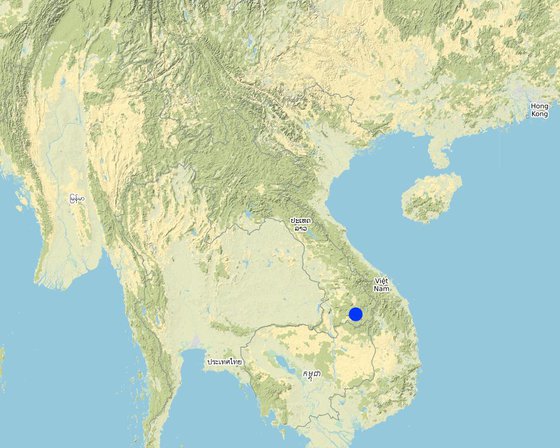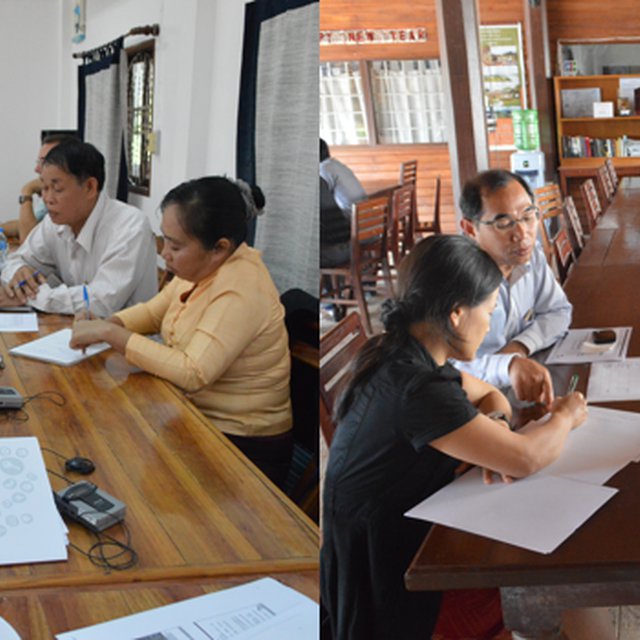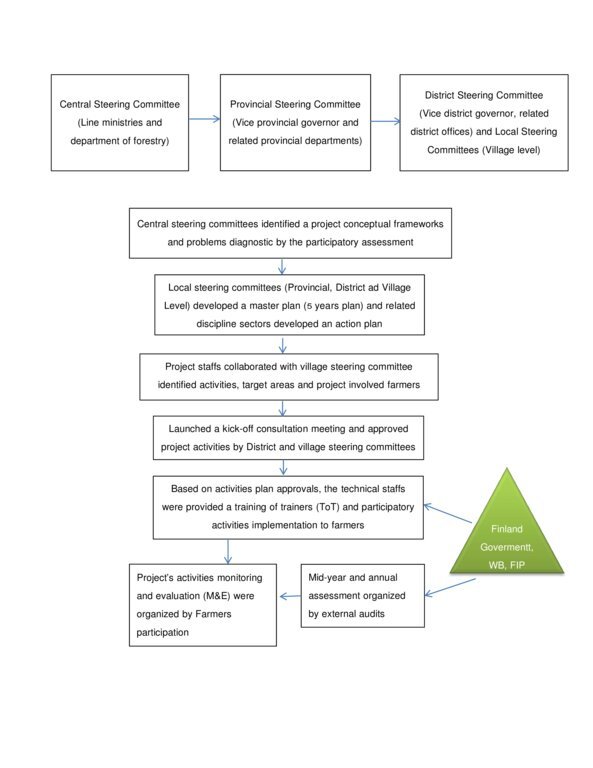ການຈັດສັນຄຸ້ມຄອງປ່າໄມ້ແບບຍືນຍົງ
(Lao People's Democratic Republic)
SUFORD-SU
Description
ການຈັດການຄຸ້ມຄອງປ່າໄມ້ແບບຍືນຍົງ ໂດຍສະເພາະ ແມ່ນການຈັດການຄຸ້ມຄອງ ການນາໍໃຊ້ເຂດປ່າຜະລິດພາຍໃນຊຸມຊົນ ໃຫ້ມີຄວາມແບບຍືນຍົງ ຄຽງຄູ່ກັບການປັບປຸງການດຳລົງຊີວິດ ຂອງຊາວກະສິກອນໃນທ້ອງຖີ່ນ.
ໂຄງການຈັດການຄຸ້ມຄອງປ່າໄມ້ແບບຍືນຍົງ ໃນໄລຍະຂະຫຍາຍ ເປັນໂຄງການຊຸກຍູ້ ກ່ຽວກັບການຈັດການຄຸ້ມຄອງປ່າໄມ້ແບບຍືນຍົງ ຊື່ງໄດ້ລິເລີ່ມມາໄດ້ 3 ໄລຍະ. ໃນໄລຍະທຳອິດປີ ແມ່ນເລີ່ມຈັດຕັ້ງປະຕິບັດໂຄງການແຕ່ປີ 2003-2008 ມີຊື່ວ່າ Sustainable Forestry and Rural Development (SUFORD), ໃນໄລຍະທີສອງ ເລີ່ມຈັດຕັ້ງປະຕິບັດແຕ່ປີ 2009-2014 ເປັນໄລຍະສືບຕໍ່ງົບປະມານ ມີຊື່ວ່າ Sustainable Forestry and Rural Development Project – Additional financing (SUFORD AF), ໃນໄລຍະທີ່ສາມ ເລີ່ມຈາກປີ 2014-2017 ເປັນໄລຍະສືບຕໍ່ຂະຫຍາຍບັນດາກິດຈະກຳຂອງໂຄງການເດີມ ເຊິິ່ງມີຊື່ວ່າ Scaling up Participatory Sustainable Forest Management (SUFORD SU). ໂຄງການດັ່ງກ່າວໄດ້ຮັບການຄຸ້ມຄອງ ຈາກພາກລັດຖະບານ ໂດຍກົມປ່າໄມ້ ກະຊວງກະສິກຳ ແລະ ປ່າໄມ້ ເປັນເຈົ້າຂອງໂຄງການ ຊື່ງມີການຈັດຕັ້ງບໍລິຫານ ນັບແຕ່ຂັ້ນສູນກາງຈົນຮອດຂັ້ນທ້ອງຖີ່ນ ໂດຍຜ່ານຄະນະບໍລິຫານງານ ແລະ ຊີ້ນຳໂຄງການແຕ່ລະຂັ້ນເຊັ່ນ: ຂັ້ນສູນກາງ ໄດ້ແກ່ກົມປ່າໄມ້ ແລະ ບັນດາຜູ້ໃຫ້ທືນ; ຄະນະບໍລິຫານງານຂັ້ນແຂວງໄດ້ແກ່ ຮອງເຈົ້າແຂວງ, ເຈົ້າເມືອງ, ແລະ ບັນດາພະແນກການຕ່າງໆທີ່ກ່ຽວຂ້ອງ, ລົງສູ່ລະດັບຂັ້ນເມືອງ ໄດ້ມີການຈັດຕັ້ງຄະນະບໍລິຫານງານຂັ້ນເມືອງ ຊື່ງປະກອບດ້ວຍ ທ່ານຮອງເຈົ້າເມືອງເປັນຄະນະຜູ້ຊີ້ນຳຂັ້ນທ້ອງຖີ່ນ ພ້ອມທັງຄະນະຜູ້ປະສານງານ ຈາກຫຼາຍພາກສ່ວນພາຍໃນເມືອງເຂົ້າຮ່ວມເຊັ່ນ: ຫ້ອງການປົກຄອງເມືອງ, ຫ້ອງການກະສິກຳ ແລະ ປ່າໄມ້, ຫ້ອງການຊັບພະຍາກອນທຳມະຊາດ, ຫ້ອງການອຸດສາຫະກຳ ແລະ ການຄ້າ, ອົງການຈັດຕັ້ງມະຫາຊົນ (ແນວລາວສ້າງຊາດ, ສະຫະພັນແມ່ຍີງ). ໂດຍອີງໃສ່ ແຜນການຈັດຕັ້ງປະຕິບັດຂອງຂັ້ນສູນກາງ ແລະ ຜັນຂະຫຍາຍເປັນແຜນການປະຕິບັດ ແລະ ກິດຈະກຳຂອງຂັ້ນແຂວງ ແລະ ເມືອງ ຕາມລຳດັບ. ໂດຍຜ່ານ ກົມປ່າໄມ້ ສ້າງແຜນການຈັດຕັ້ງປະຕິບັດວຽກງານ ໂດຍການສົມທົບກັບຊ່ຽວຊານວິຊາການຂອງຝ່າຍລາວ ແລະ ຕ່າງປະເທດ ຈຳນວນໜື່ງ ທີ່ສະໜັບສະໜຸນໂດຍຜູ້ໃຫ້ທືນ ເພື່ອອອກແບບເປັນໂຄງການ, ແລ້ວສະເໜີຕໍ່ຄະນະບໍລິຫານງານຂັ້ນແຂວງ, ຂັ້ນເມືອງ ແລະ ລົງຈັດຕັ້ງປະຕິບັດບັນດາກິດຈະກຳຕ່າງໆ. ຈຸດປະສົງຂອງໂຄງການ ເພື່ອຄຸ້ມຄອງປ່າຜະລິດ ຄຽງຄູ່ກັບການປັບປຸງຊີວິດການເປັນຢູ່ ຂອງປະຊາຊົນທີ່ນຳໃຊ້ປະໂຫຍດຈາກປ່າຜະລິດ. ບັນດາກິດຈະກຳທີ່ໄດ້ຈັດຕັ້ງປະຕິບັດ ປະກອບມີ 2 ວຽກຫຼັກ ເຊັ່ນ: ການຄຸ້ມຄອງປ່າຜະລິດ ແລະ ການພັດທະນາຊີວິດການເປັນຢູ່ຂອງປະຊາຊົນ. ສຳລັບ ວຽກງານການຄຸ້ມຄອງປ່າຜະລິດ ປະກອບມີ ການສຳຫຼວດຈັດສັນປ່າ, ສ້າງແຜນທີ່ເຂດຂຸດຄົ້ນໝາຍຕົ້ນຕັດ; ສ່ວນວຽກງານການພັດທະນາຊີວິດການເປັນຢູ່ຂອງປະຊາຊົນ ລວມມີ ການສົ່ງເສີມເຕັກນິກກະສິກຳ-ປ່າໄມ້ ຫຼື Agro-forestry ແລະ ດ້ານການປູກພືດປະສົມປະສານ ຫຼື integrated farming system, ວຽກງານສົ່ງເສີມກອງທືນບ້ານ ໂດຍການສະໜອງທືນໃຫ້ບ້ານລະ 8,000 ໂດລາສະຫະລັດ ແລະ ການສົ່ງງເສີມວຽກເຮັດງານທຳ ເພື່ອລຸດຜ່ອນການຕັດໄມ້ທຳລາຍປ່າໄມ້. ນອກຈາກນີ້ ໂຄງການດັ່ງກ່າວ ຍັງໄດ້ຮັບການສະໜັບສະໜຸນທາງດ້ານທືນ, ເຕັກນິກວິຊາການ ແລະ ການຮ່ວມມືກັບລັດຖະບານ ແຫ່ງປະເທດຟີນແລນ (Finland), ທະນາຄານໂລກ (World Bank) ແລະ ໂຄງການການລົງທືນດ້ານປ່າໄມ້ (Forest Investment Programme). ຜ່ານການຈັດຕັ້ງປະຕິບັດໂຄງການ ເຫັນໄດ້ວ່າ ປະຊາຊົນໃນເຂດເປົ້າໝາຍຂອງໂຄງການ ມີຄວາມພໍໃຈສົມຄວນ ທີ່ໄດ້ມີການເຂົ້າຮ່ວມປະຕິບັດວຽກງານການຄຸ້ມຄອງປ່າໄມ້ແບບຍືນຍົງ ເພື່ອຮັກສາຊັບພະຍາກອນປ່າໄມ້ ແລະ ສີ່ງແວດລ້ອມ, ວຽກງານປ່າໄມ້ໄດ້ມີການສຳຫຼວດ ແລະ ໄດ້ເຄື່ອນໄຫວຕິດຕາມຕະຫຼອດເປັນແຕ່ລະໄລຍະ.
Location

Location: ແຂວງອັດຕະປື, Lao People's Democratic Republic
Geo-reference of selected sites
Initiation date: 2014
Year of termination: 2018
Type of Approach
-
traditional/ indigenous
-
recent local initiative/ innovative
-
project/ programme based

-
Approach aims and enabling environment
Main aims / objectives of the approach
ຈຸດປະສົງຫຼັກ ແມ່ນເພື່ອຄຸ້ມຄອງປ່າຜະລິດ ຄຽງຄູ່ກັບການປັບປຸງຊີວິດການເປັນຢູ່ ຂອງປະຊາຊົນທີ່ນຳໃຊ້ປະໂຫຍດຈາກປ່າຜະລິດ
Conditions enabling the implementation of the Technology/ ies applied under the Approach
-
Social/ cultural/ religious norms and values: ພະຍາຍາມເຮັດວຽກຮ່ວມກັບຊຸມຊົນ ກຳນົດແຈ້ງບົດບາດ ແລະ ການມີສ່ວນຮ່ວມ ຕະຫຼອດຮອດ ຮິດຄອງປະເພນີຕ່າງໆ
-
Availability/ access to financial resources and services: ທາງໂຄງການໄດ້ມອບທືນສະໜັບສະໜຸນໃຫ້ບ້ານໝູນໃຊ້ເຂົ້າໃນວຽກງານຄຸ້ມຄອງປ່າໄມ້ໃຫ້ຍືນຍົງ
-
Institutional setting: ສ້າງຕັ້ງຫ້ອງການໃນຂັ້ນເມືອງ
-
Collaboration/ coordination of actors: ໄດ້ສ້າງລະບົບການມີສ່ວນຮ່ວມ ໃນແຕ່ລະຂັ້ນ ( ສູນກາງ, ແຂວງ, ເມືອງ, ບ້ານ),
-
Legal framework (land tenure, land and water use rights): ໄດ້ສ້າງຕັ້ງຄະນະກຳມະການດ້ານປ່າໄມ້ ໂດຍຜ່ານກົມກວດກາປ່າໄມ້ ເພື່ອເຜີຍແຜ່ນິຕິກຳ, ລະບຽບກົດໝາຍ ທີ່ກ່ຽວກັບ ປ່າໄມ້
-
Knowledge about SLM, access to technical support: ສ້າງຄູຝຶກ ກ່ຽວກັບ ການຟື້ນຟູປ່າໄມ້ ແລະ ກະສິກຳປະສົມປະສານ
-
Markets (to purchase inputs, sell products) and prices: ຊຸກຍູ້ລະບົບການການນຳໃຊ້ເຄື່ອງປ່າຂອງດົງດ້ວຍຕ່ອງໂສ້ການຕະຫຼາດ
-
Workload, availability of manpower: ປະຊາຊົນມີຄວາມພ້ອມ ມີຄວາມເຂົ້າໃຈ ໃນການເປັນເຈົ້າການຈັດຕັ້ງປະຕິບັດ ແລະ ໂຄງການໄປຊ່ວຍເສີມບາງອັນທີ່ຈຳເປັນ
Conditions hindering the implementation of the Technology/ ies applied under the Approach
Participation and roles of stakeholders involved
Stakeholders involved in the Approach and their roles
| What stakeholders / implementing bodies were involved in the Approach? |
Specify stakeholders |
Describe roles of stakeholders |
| local land users/ local communities |
ຜູ້ນາໍໃຊ້ດີນ |
ຜູ້ຈັດຕັ້ງປະຕິບັດກິດຈະກາໍໂຄງການ |
| community-based organizations |
ອົງການຊາວໜຸ່ມ ແລະ ສະຫະພັນແມ່ຍີງ |
ປະກອບສ່ວນຊຸກຍູ້ສົ່ງເສີມ ແລະ ປູກລະດົມ ໃນວຽກງານທີ່ຕິດພັນກັບແມ່ຍີງ |
| teachers/ school children/ students |
ນັກສຶກສາຈາກມະວິທະຍາໄລ ສະຫວັນນະເຂດ |
ສຳຫຼວດເກັບກາໍຂໍ້ມູນປ່າຜະລິດ, ສຳຫຼວດຈັດສັນ ແລະ ເກັບຕົວຢ່າງຊະນິດພັນພືດ ໃນເຂດປ່າຜະລິີດ ພາຍໃນບ້ານເປົ້າໝາຍຂອງໂຄງການ |
| local government |
ນາຍບ້ານ ແລະ ອາໍນາດການປົກຄອງບ້ານ |
ປູກລະດົມ ຂົນຂວາຍປະຊາຊົນ ໃນການເຂົ້າຮ່ວມກອງປະຊຸມຂັ້ນບ້ານ ແລະ ອາໍນວຍຄວາມສະດວກໃນການດຳເນີນຈັດກອງປະຊຸມ |
| national government (planners, decision-makers) |
ກົມປ່າໄມ້ |
ອາໍນວຍຄວາມສະດວກໃນການປະສານງານ, ກຳນົດແຜນການຈັດຕັ້ງປະຕິບັດວຽກງານ ແລະ ຕິດຕາມປະເມີນຜົນການຈັດຕັ້ງປະຕິບັດວຽກງານ. |
| international organization |
ທະນາຄານໂລກ (World Bank) ແລະ ໂຄງການການລົງທືນດ້ານປ່າໄມ້ (Forest Investment Programme) |
ສະໜັບສະໜຸນທາງດ້ານທືນ, ເຕັກນິກວິຊາການ ໃນການສ້າງ ແລະ ກຳນົດແຜນການຈັດຕັ້ງປະຕິບັດວຽກງານ ແລະ ຕິດຕາມປະເມີນຜົນໂຄງການ. |
Involvement of local land users/ local communities in the different phases of the Approach
none
passive
external support
interactive
self-mobilization
Decision-making on the selection of SLM Technology
Decisions were taken by
-
land users alone (self-initiative)
-
mainly land users, supported by SLM specialists
-
all relevant actors, as part of a participatory approach
-
mainly SLM specialists, following consultation with land users
-
SLM specialists alone
-
politicians/ leaders
Decisions were made based on
-
evaluation of well-documented SLM knowledge (evidence-based decision-making)
-
research findings
-
personal experience and opinions (undocumented)
Technical support, capacity building, and knowledge management
The following activities or services have been part of the approach
-
Capacity building/ training
-
Advisory service
-
Institution strengthening (organizational development)
-
Monitoring and evaluation
-
Research
Capacity building/ training
Training was provided to the following stakeholders
-
land users
-
field staff/ advisers
Form of training
-
on-the-job
-
farmer-to-farmer
-
demonstration areas
-
public meetings
-
courses
Subjects covered
1. ການສຳຫຼວດຂຸດຄົ້ນປ່າໄມ້ (ຈັດສັນກາໍນົດເຂດຟື້ນຟູ)
2. ສົ່ງເສີມເຕັກນິກການປູກ-ການລ້ຽງ, ທັດສະນະສຶກສາ
3. ການຈັດສັນຄຸ້ມຄອງກອງທືນຂັ້ນບ້ານ (ການຈັດຊື້-ຈັດຊື້-ຈັດຈ້າງ), ການຄຸ້ມຄອງການໃຊ້ຈ່າຍ
Advisory service
Advisory service was provided
-
on land users' fields
-
at permanent centres
-
ຜ່ານການໃຊ້ໂທລະສັບ ໂດຍກົງ
Institution strengthening
Institutions have been strengthened / established
-
no
-
yes, a little
-
yes, moderately
-
yes, greatly
Describe institution, roles and responsibilities, members, etc.
Type of support
-
financial
-
capacity building/ training
-
equipment
Further details
Monitoring and evaluation
Research
Research treated the following topics
-
sociology
-
economics / marketing
-
ecology
-
technology
-
ດ້ານການເງີນ, ການຄຸ້ມຄອງການເງີນ
ຊ່ຽວຊານປະຈຳໂຄງການຂັ້ນແຂວງ
Financing and external material support
Annual budget in USD for the SLM component
-
< 2,000
-
2,000-10,000
-
10,000-100,000
-
100,000-1,000,000
-
> 1,000,000
Precise annual budget: 400000.0
The following services or incentives have been provided to land users
-
Financial/ material support provided to land users
-
Subsidies for specific inputs
-
Credit
-
Other incentives or instruments
Financial/ material support provided to land users
ຜູ້ເຂົ້າຮ່ວມກິດຈະກຳ ໃນເວລາຈັດຕັ້ງປະຕິບັດ ຈະໄດ້ຮັບອັດຕາກິນ 50000 ກີບຕໍ່ມື້ (ສາໍລັບກີດຈະກໍາການຟື້ນຟູປ່າ ແລະ ວຽກງານສຳຫຼວດປ່າ)
partly financed
fully financed
equipment: machinery
ໃນກໍລະນີຜູ້ເຂົ້າຮ່ວມກິດຈະກຳມີເຄື່ອງກົນຈັກ
equipment: machinery: tools
agricultural: seeds: fertilizers
Labour by land users was
-
voluntary
-
food-for-work
-
paid in cash
-
rewarded with other material support
Impact analysis and concluding statements
Impacts of the Approach
No
Yes, little
Yes, moderately
Yes, greatly
Did the Approach empower local land users, improve stakeholder participation?
ເປັນກິດຈະກາໍໂຄງການສືບຕໍ່ ຊຶ່ງໄດ້ມີການຖອດຖອນບົດຮຽນຈາກປະສົບການຂອງໂຄງການເກົ່າ
Did the Approach enable evidence-based decision-making?
ການນຳໃຊ້ສາລີ, ການປ້ອງກັນພະຍາດສັດ, ການຂ້າຫຍ້າ
Did the Approach help land users to implement and maintain SLM Technologies?
Did the Approach improve coordination and cost-effective implementation of SLM?
Did the Approach mobilize/ improve access to financial resources for SLM implementation?
Did the Approach improve knowledge and capacities of land users to implement SLM?
Did the Approach improve knowledge and capacities of other stakeholders?
Did the Approach build/ strengthen institutions, collaboration between stakeholders?
Did the Approach mitigate conflicts?
ໂດຍສະເພາະການຫ້າມບໍ່ໃຫ້ຂະຫຍາຍເນື້ອທີ່ການປູກພືດອື່ນ ໃນເຂດປ່າຜະລິດ ແລະ ການຕັດໄມ້
Did the Approach empower socially and economically disadvantaged groups?
ເປັນກຸ່ມຫຼັກ ແລະ ບູລິມະສິດ
Did the Approach improve gender equality and empower women and girls?
Did the Approach encourage young people/ the next generation of land users to engage in SLM?
ອອກແຮງງານ, ກິດຈະກຳປູກຈິດສຳນຶກ ສົ່ງເສີມວຽກງານປູກຕົ້ນໄມ້
Did the Approach improve issues of land tenure/ user rights that hindered implementation of SLM Technologies?
Did the Approach lead to improved food security/ improved nutrition?
Did the Approach improve access to markets?
Did the Approach lead to improved access to water and sanitation?
Did the Approach lead to more sustainable use/ sources of energy?
Did the Approach improve the capacity of the land users to adapt to climate changes/ extremes and mitigate climate related disasters?
Did the Approach lead to employment, income opportunities?
Main motivation of land users to implement SLM
-
increased production
-
increased profit(ability), improved cost-benefit-ratio
-
reduced land degradation
-
reduced risk of disasters
-
reduced workload
-
payments/ subsidies
-
rules and regulations (fines)/ enforcement
-
prestige, social pressure/ social cohesion
-
affiliation to movement/ project/ group/ networks
-
environmental consciousness
-
customs and beliefs, morals
-
enhanced SLM knowledge and skills
-
aesthetic improvement
-
conflict mitigation
Sustainability of Approach activities
Can the land users sustain what hat been implemented through the Approach (without external support)?
ປະຊາຊົນໂດຍລວມມີຄວາມໝັ້ນໃຈສູງໃນການເຂົ້າຮ່ວມທຸກກິດຈະກຳ ດ້ວຍການມີສ່ວນຮ່ວມ ແລະ ທຸກພາກສ່ວນ, ໃນກໍລະນີຜູ້ທີ່ລະເມີດ ຫຼືກະທຳຜິດ ກໍ່ມີການວາງລະບຽບ, ປັບໄໝ. ເຖີງຢ່າງໃດກໍ່ຕາມ ໂຄງການນີ້ກໍ່ເປັນສີ່ງທີ່ດີ ແລະ ຄວນຈະມີການສືບຕໍ່ສະໜັບສະໜຸນຢ່າງຕໍ່ເນື່ອງ
Conclusions and lessons learnt
Strengths: land user's view
-
ລະບົບການຈັດການຄຸ້ມຄອງປ່າໄມ້ທີ່ດີຂື້ນ ແລະ ເພີ່ມການປົກຫຸ້ມປ່າໄມ້
-
ຫຼຸດຜ່ອນບັນຫາການລັກລອບຕັດໄມ້
-
ປະຊາຊົນທ້ອງຖີ່ນມີຄວາມເປັນເຈົ້າການໃນການປົກປັກຮັກສາປ່າໄມ້ຫຼາຍຂຶ້ນ
-
ປະຊາຊົນ ແລະ ຜູ້ຈັດຕັ້ງປະຕິບັດໂຄງການ ໄດ້ຮັບການຊຸກຍູ້ ສະໜັບສະໜູນທາງດ້ານເຕັກນີິກວິຊາການ, ເຄື່ອງມື ແລະ ອຸປະກອນຈາກຊ່ຽວຊານທັງພາຍໃນ ແລະ ຕ່າງປະເທດ
Strengths: compiler’s or other key resource person’s view
-
ໂຄງການດັ່ງກ່າວ ມີຂະບວນການຈັດຕັ້ງປະຕິບັດວຽກງານ ທີ່ເນັ້ນໃສ່ການມີສ່ວນຮ່ວມໃນທຸກພາກສ່ວນທີ່ກ່ຽວຂ້ອງຢ່າງກົມກຽວ
-
ມີງົບປະມານຈັດສັນທີ່ເໝາະສົມ ແລະ ສ້າງຄວາມເຂັ້ມແຂງພາຍໃນຊຸມຊົນໄດ້ເປັນຢ່າງດີ
-
ປັບປຸງຊີວິດການເປັນຢູ່ຂອງປະຊາຊົນ ພາຍໃນເຂດທີ່ໃກ້ຄຽງກັບປ່າຜະລິດ ແລະ ສ້າງໃຫ້ເຂົາເປັນເຈົ້າການໃນການປົກປັກຮັກສາປ່າຜະລິດ
Weaknesses/ disadvantages/ risks: land user's viewhow to overcome
-
ຄວາມເປັນເຈົ້າການຂອງປະຊາຊົນທ້ອງຖີ່ນ ເນື່ອງຈາກຈາໍນວນນຶ່ງຍັງມີແນວຄິດວ່າເປັນວຽກຂອງໂຄງການ
ປັບປຸງຂອດການຈັດຕັ້ງ, ມອບສິດຂາດຕົວ ເພື່ອໃຫ້ເຂົາ ບໍ່ມີຫຼາຍໜ້າວຽກ ແລະ ມີການສືບຕໍ່ເຮັດວຽກດັ່ງກ່າວຢ່າງຕໍ່ເນື່ອງ
-
ການໃຫ້ຂໍ້ມູນຍັງບໍ່ທັນຊັດເຈນ, ການປະຊຸມ ແລະ ການລວມກັນພາຍໃນກຸ່ມຍັງບໍ່ມີິຄວາມຫຼາກຫຼາຍເທົ່າທີ່ຄວນ
ພະຍາຍາມອະທິບາຍໃຫ້ເຂົາເຈົ້າເຂົ້າໃຈແຈ້ງແຕ່ຫົວທີໂລດ ແລະ ຕ້ອງອະທິບາຍຕະຫຼອດ ໃນການເຮັດວຽກເປັນກຸ່ມ ເພື່ອປູກຈິດສຳນຶກໃນລະດັບຕ່າງກັນ ທາງດ້ານການສ້າງຄວາມສາມາດໃຫ້ວິຊາການ
-
ການສະໜອງທືນຮອນໃນການຈັດຕັ້ງປະຕິບັດ ເຫັນວ່າບາງບ້ານຄິດໄລ່ແບບງ່າຍດາຍ ຂາດການວິເຄາະວິໃຈ
ສ້າງຄວາມເຂົ້າໃຈລະອຽດ ແລະ ໃຫ້ການປືກສາຫາລືເປັນປະຈຳ
-
ລະບົບການປະສານງານລາຍງານ ແລະ ການສະໜອງງົບປະມານ ໃນການຈັດຊື້ ຈາກຂັ້ນສູນກາງມີການຊັກຊ້າ
Weaknesses/ disadvantages/ risks: compiler’s or other key resource person’s viewhow to overcome
-
ຜູ້ທີ່ໄດ້ເຂົ້າຮວມຝຶກອົບຮົມ ຈະມີການຍົກຍ້າຍໄປເຮັດວຽກຕາມຄວາມຈຳເປັນ
ການຝຶກອົບຮົມດ້ານຕ່າງໆຕ້ອງໄດ້ມີການປະຕິບັດຢ່າງຕໍ່ເນື່ອງ
-
ການສະໜັບສະໜຸນດ້ານງົບປະມານຊັກຊ້າ
ຄງນລຸດຜ່ອນກະບວນການພິຈາລະນາລົງ ແລະ ເຮັດໃຫ້ງົບປະມານລົງສູ່ ທ້ອງຖີ່ນໃຫ້ຫຼາຍຂື້ນ
References
Editors
-
Bounthanom Bouahom
-
kang phanvongsa
-
viengsavanh phimphachanhvongsod
Reviewer
-
Nicole Harari
-
William Critchley
Date of documentation: Okt. 30, 2018
Last update: Maart 8, 2021
Resource persons
-
ເກດສະໜາ ປັນຕະຍານົນ (kedsana3689@gmail.com) - ຜູ້ປະສານງານຂັ້ນແຂວງ
-
ປະຊາລັດ ຂຸນສີ (pasalathkh@gmail.com) - SLM specialist
Full description in the WOCAT database
Documentation was faciliated by
Institution
- National Agriculture and Forestry Research Institute (NAFRI) - Lao People's Democratic Republic
Project
- Scaling-up SLM practices by smallholder farmers (IFAD)






